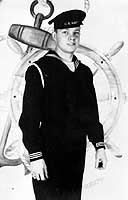
Richard De Wert was born on 17 November 1931 in Taunton, Massachusetts. He enlisted in the U.S. Navy in December 1948. Following "boot camp" and Hospital Corps training at Great Lakes, Illinois, he was assigned to the Naval Hospital at Portsmouth, Virginia, during 1949-50. In July 1950, he joined the Fleet Marine Force and soon sailed for the Far East to take part in the Korean War. Landing with the First Marine Division at Inchon in September 1950, Hospitalman De Wert participated in operations to liberate the city of Seoul. During the rest of 1950, he was involved in the landings at Wonsan, the Chosin Reservoir Campaign and the Hungnam Evacuation.
In 1951 Hospitalman De Wert served with the Marines as they cleared North Korean guerrillas from rural areas of South Korea and as they helped drive the enemy beyond the Thirty-eighth Parallel. On 5 April 1951, while with the 2nd Battalion, 7th Marines during an attack on Chinese Communist forces, De Wert persistently, and in spite of his own wounds, moved through fire-swept ground to aid fallen Marines. He was killed in action while administering first aid to an injured comrade. For his great heroism on this occasion, Hospitalman Richard De Wert was posthumously awarded the Medal of Honor.
USS De Wert (FFG-45) was named in honor of Hospitalman De Wert.
This page features our only view of Richard De Wert.
| If you want higher resolution reproductions than the "Online Library's" digital images, see: "How to Obtain Photographic Reproductions." |
Click on the small photograph to prompt a larger view of the same image.
|
Photo #: 80-G-442505 Richard De Wert, Hospitalman, USNR Photographed circa 1949-50. He was posthumously awarded the Medal of Honor for heroism in combat on 5 April 1951, while serving with the Seventh Marines in Korea. Official U.S. Navy Photograph, now in the collections of the National Archives. Online Image: 52KB; 475 x 765 pixels Reproductions of this image may also be available through the National Archives photographic reproduction system. |
 |
|
Medal of Honor citation of Hospitalman Richard De Wert (as printed in the 1964 Congressional publication "Medal of Honor Recipients --1863-1963", pages 745-46): |
| If you want higher resolution reproductions than the "Online Library's" digital images, see: "How to Obtain Photographic Reproductions." |
1 September 2000